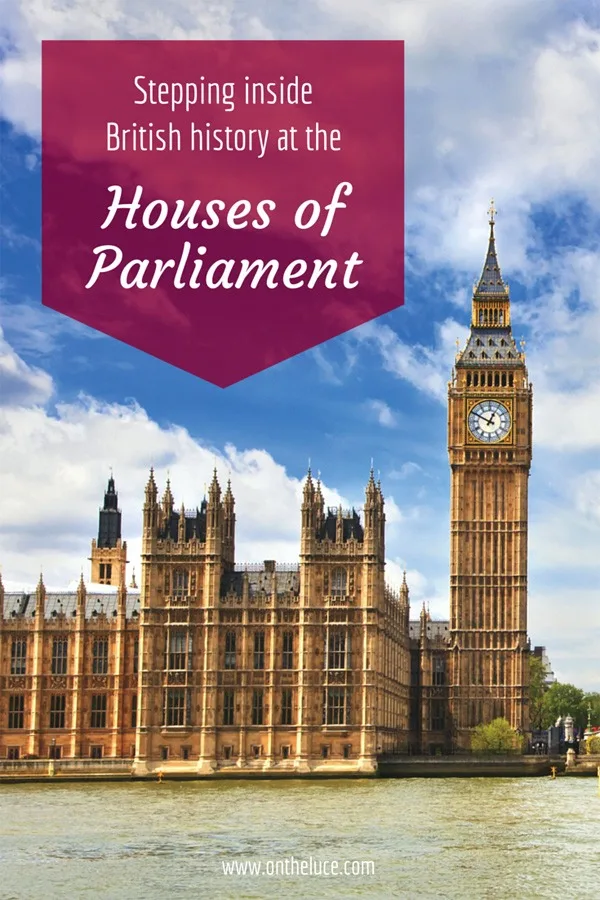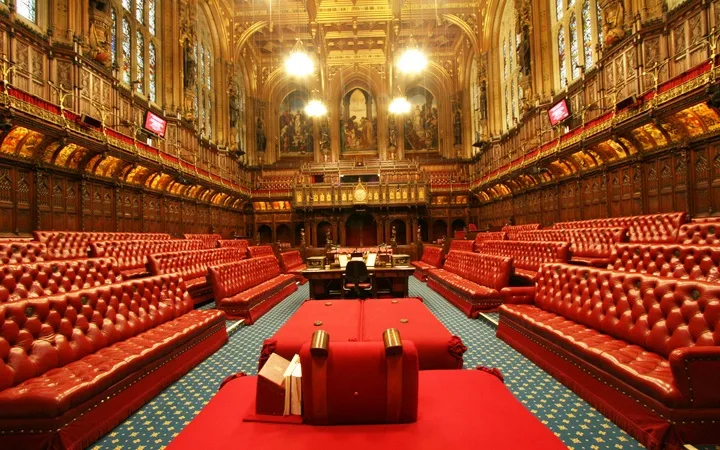
The Palace of Westminster – home to the Houses of Parliament – is one of London’s best-known buildings, its towers forming the backdrop to so many images of the capital. But although almost everyone can recognise it from the outside, what goes on inside is a bit more of a mystery. The complex rituals and history of the British political system are enough to confuse anyone. But where better to find out about them than in the place that so much of British history took place. On a recent trip to London I finally made it inside to explore some of the building’s stories of intrigue, disaster and triumph over the last 1000 years.
We’d booked in for an hour-long self-guided audio tour of the building. Tours are timed so you need to make sure to get there in time to get through the airport-style security process (who were slightly perplexed as to why I had a mini bottle of ice cider with me – a present from a meeting that morning!). Fully scanned and searched, we were handed security badges and sent on through to the starting point of the tour, the cavernous Westminster Hall – dating back to 1097 this is the oldest part of the Palace of Westminster.
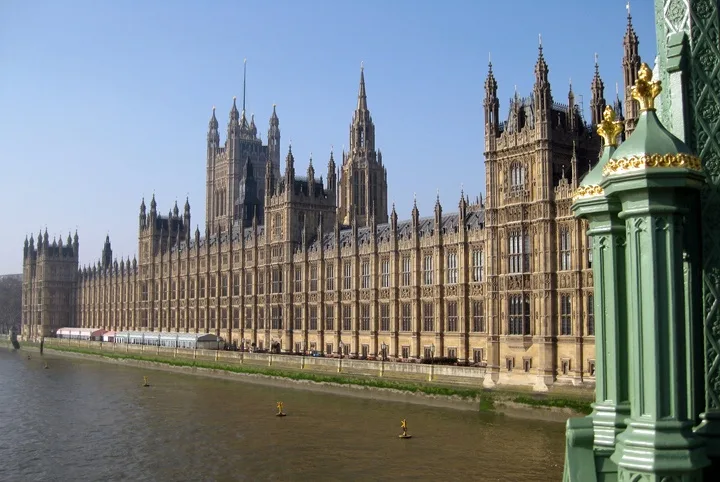
The famous exterior of the Houses of Parliament
The Hall has played many different roles over the last 1000 years, first as a courtroom where famous names like Guy Fawkes and William Wallace were tried. Then it was used for lavish coronation banquets for new monarchs, and plaques in the stone floor mark the places that famous leaders were laid in state before their funerals. These days it’s mostly used for important visitors like Nelson Mandela and Barack Obama as it’s one of the few places big enough for them to address both Houses of Parliament at once.
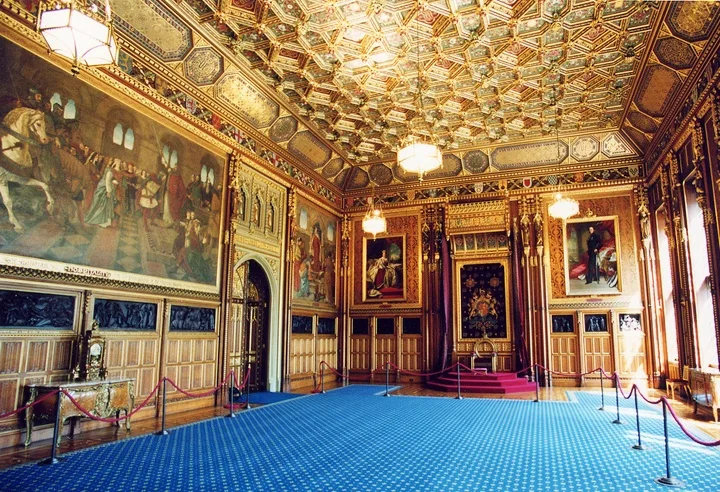
The Queen’s Robing Room
Westminster Hall is one of the few original parts of the building left as a huge fire destroyed the rest in 1834. A lucky change of wind direction saved the Hall, but the original Houses of Parliament had to be rebuilt in their current Victorian neo-Gothic style. As the tour moves through the building it follows the route the Queen takes when she visits for the State Opening of Parliament. After coming in via a special ‘Sovereign’s Entrance’, she heads to the Queen’s Robing Room to put on her crown and cloak. The room is decorated with paintings of Arthurian legends and has a grand throne of gold and purple velvet for her to sit on. It was designed for Queen Victoria and there’s a special reminder of her – a footstool was made for her to go under the throne because at under five-foot tall she didn’t want her feet to be dangling off the floor!
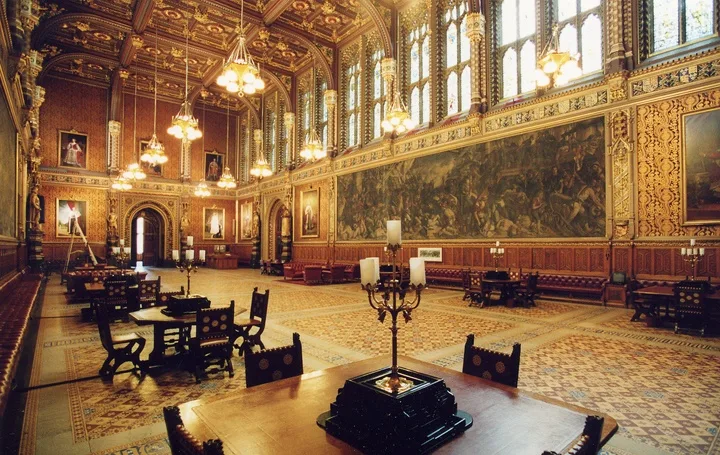
Enormous frescoes in the Royal Gallery
Once she’s suitably dressed, the Queen carries on along the Royal Gallery. This is one of the biggest rooms in the Palace and has frescoes around the walls showing great British military victories like the Battles of Trafalgar and Waterloo. Though in the interest of Anglo-French relations there are apparently hooks above the pictures so they can be covered up with curtains when French Heads of State pay a visit! The next room is the Prince’s Chamber, an anteroom where the Lords can meet to discuss business. The walls are covered with paintings of 28 Tudor monarchs – including Henry VIII and all of his wives.
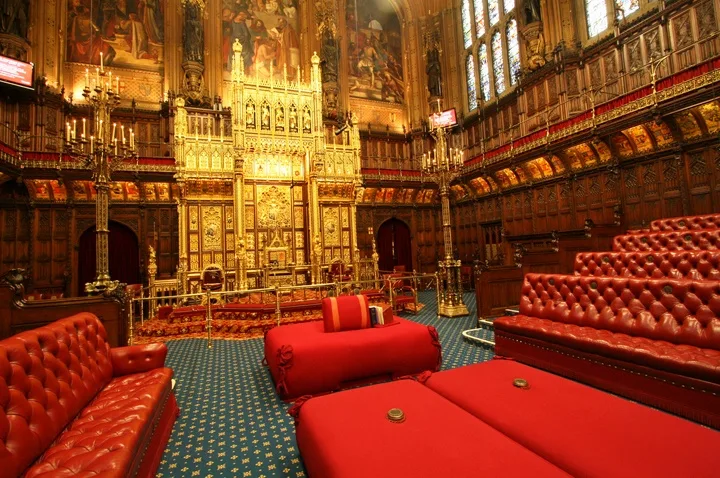
The lavish interior of the House of Lords
Then it’s on into the House of Lords, one of the most lavishly decorated parts of the building, full of deep golds and bright reds. Having seen it so many times on TV, the biggest surprises were the beautiful stained glass windows and frescoes above the benches. That and the forest of microphones which hang down to capture every word of the debates. At the front of the room is an ornate throne where the Queen sits, partly made of solid gold, and the Woolsack – a big red cushion where the Speaker of the House of Lords sits. It gets its odd name from its 14th-century origins, when Edward III decided that his Lord Chancellor should sit on a bale of wool to show how important the wool trade was to the country. It’s still made of wool today, though unfortunately we weren’t allowed to test out how comfortable it was.
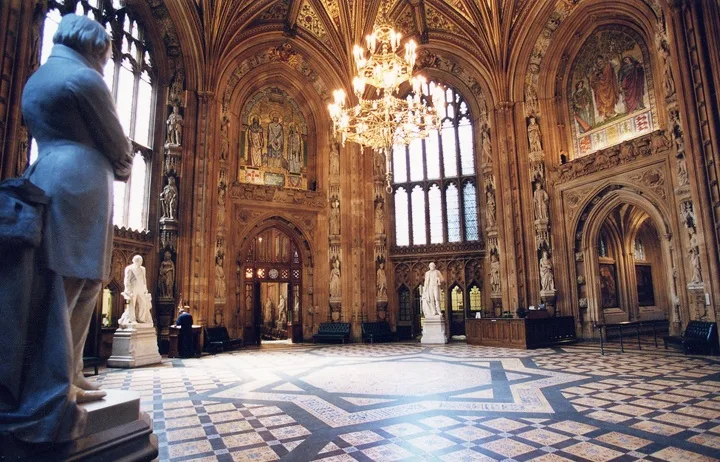
The octagonal Central Lobby
From the gold and glamour of the ceremonial rooms, the tour goes on to the areas used for the everyday business of running the country. The Central Lobby is the crossroads between the House of Lords and the House of Commons and if all the doors are left open you can see all the way from the Royal Throne at one end to the Speaker’s Chair at the other. It’s also the place where the public can come and “lobby” their local Member of Parliament if they have a problem they want help with. Next door is the Members’ Lobby, lined with statues of 20th-century Prime Ministers. Wartime leaders Winston Churchill and David Lloyd George stand near the door to the House of Commons and if you look at their feet they’re shinier than the rest of them – its said to be good luck for new MPs to rub them before they do their maiden speech.
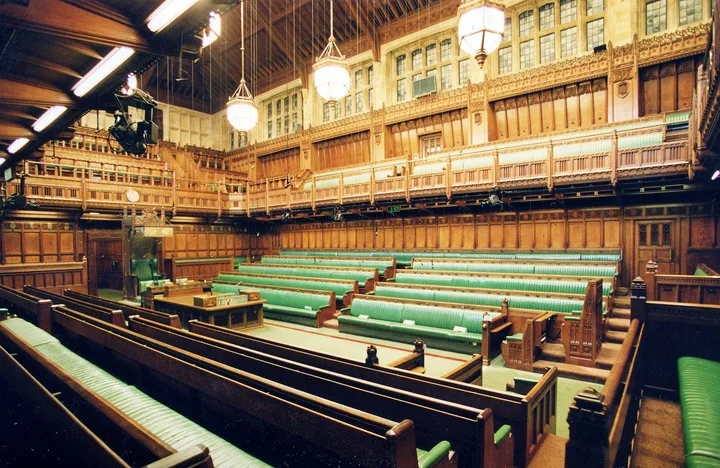
Inside the House of Commons
Next we carried on into the House of Commons, unlike the Queen as tradition means she isn’t allowed inside. It seems quite simple and subdued compared to the House of Lords and is much more recent too – after being destroyed by bombs in the Blitz this part of the building was rebuilt in the 1950s. It was built by architect Giles Gilbert Scott, who designed all sorts of other things from Waterloo Bridge and Battersea Power Station to the red telephone box. The room is deceptively small, thanks to Churchill it seems as when it was rebuilt he wanted to keep the original intense atmosphere. The green benches only seat about two-thirds of the MPs so during busy debates the room is overflowing with people. The Speaker’s chair is at the end of the room, with the Government to their right and the Opposition to their left.
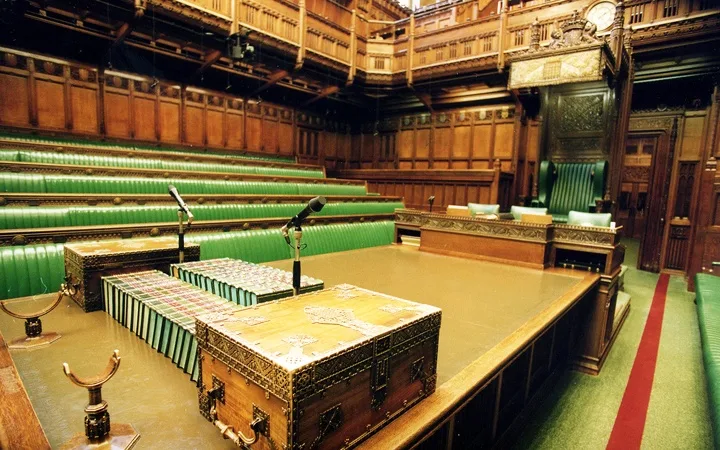
The Opposition’s Despatch Box in the House of Commons
From the Commons it’s back to Westminster Hall and the end of the tour. The Palace of Westminster is a fascinating place to visit, and I feel like I learnt a huge amount about the history and traditions that lie at the heart of British politics. Even growing up in the UK there was so much that was a mystery to me before. But having done the theory I now want to go back and see it in practice – to experience the Houses of Parliament as they should be, packed full of people with the shouts of politicians heckling each other across the benches. So next time I’ll be joining the queue for the public gallery to see how it’s really done!
The details
The Houses of Parliament are open to the public most Saturdays and selected weekdays during the summer, Easter and Christmas Parliamentary recesses – Visit Parliament have a list of the latest dates. You can choose between a guided or audio tour, both available in a range of languages. Audio tours take about an hour and cost £18.50 per adult (concessions £16 and free entry for one child under 15 per adult). Guided tours take about 100 minutes and cost £25.50 per adult (concessions £21 and children £11). If you’re a UK resident you can also arrange a free guided tour via your Member of Parliament, which is the only way you can get up into the Big Ben clocktower too, though you need to book about six months in advance.
Pin it
Note: photography is not allowed on the tour, so all images used are Parliamentary copyright and are reproduced with the permission of Parliament under Creative Commons.

